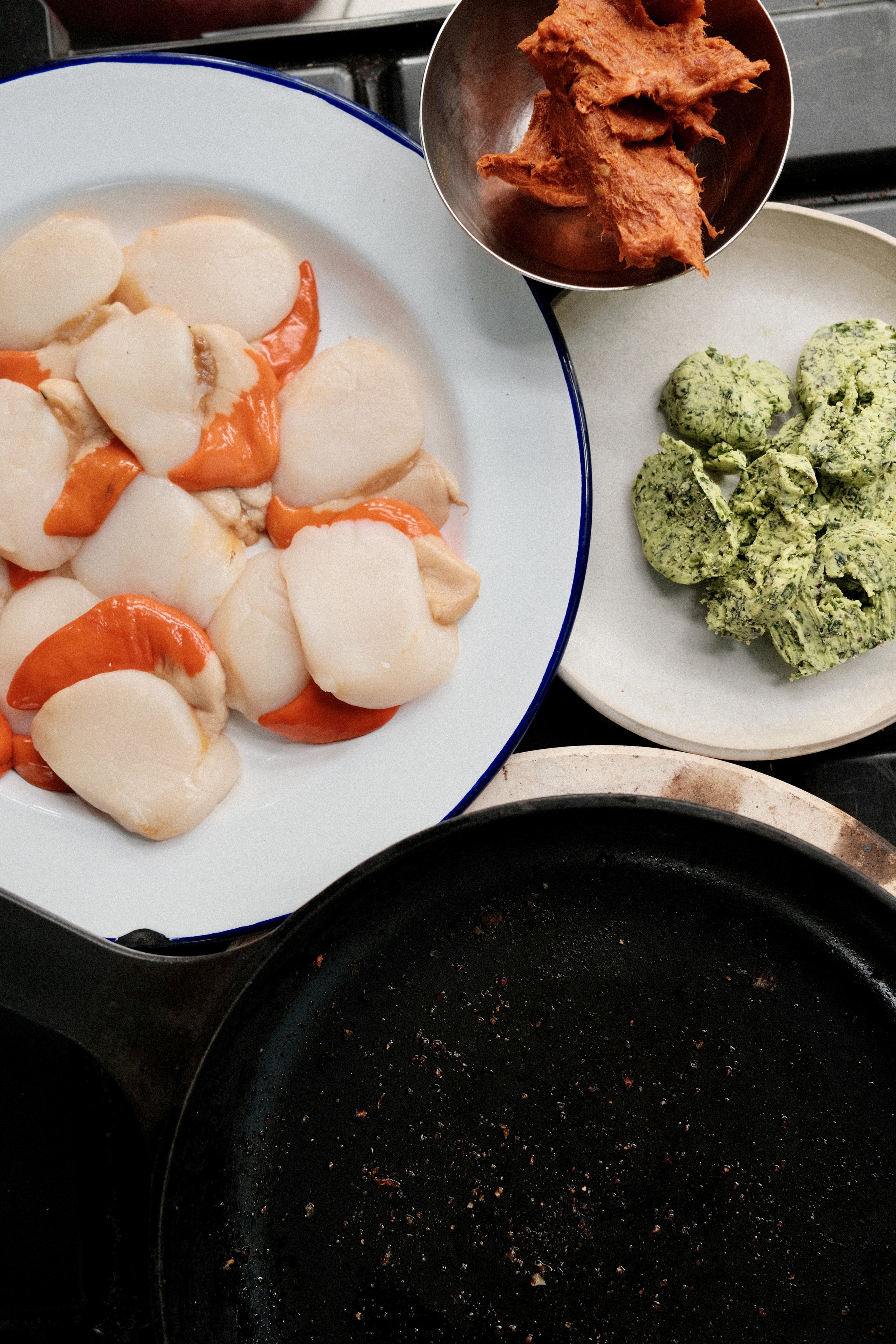NDUJA & WILD GARLIC SCALLOPS, ROASTED CABBAGE AND LEMON SUMAC YOGHURT
For this recipe we’re making use of the Gozney Roccbox’s high heat and rolling flame to cook everything hot and fast, retaining maximum tenderness and flavour on both the scallops and the cabbage. You could also assemble this by pan frying the scallops as they’re more traditionally cooked, and roasting the cabbage on a high heat in your conventional oven. Or just BBQ everything if you’re out on the campsite. That’d do nicely.
We think a dozen scallops is enough for a nice lunch for 3-4 people, or as a great starter for larger groups with one or two scallops each.
Ingredients
For the dressing
3 tbsp of full fat Greek yoghurt
2 tsp Field Blends lemon sumac & green herb blend
Juice of 1/2 a lemon
A small bunch of garlic mustard leaf, chopped. (Alternatively parsley will do!)
For the cabbage
A head of good quality white cabbage, cut into wedges
Olive oil
For the wild garlic butter
A handful of wild garlic
Butter
Field Blends SPG
A clove of garlic
Lemon zest
Garlic mustard leaves or parsley
For the scallops
A dozen scallops, we’re using these hand dived beauties from Wylde Market. If you have the shells even better, but we’re going straight into a cast iron.
75g N’duja, or sobrassada
75g wild garlic butter
Method
1) Get your pizza oven going with either wood or gas so it has chance to come up to temperature. We’re aiming for 300-350ºC here so doesn’t need to be Neapolitan pizza hot, but still way hotter than conventional ovens can usually get. If you’re working with a conventional oven get this preheated as hot as possible (usually around 220ºC) for the cabbage.
2) Wash your scallops by very quickly dipping them into clean water. You don’t want to soak them as we want them as dry as possible. Pat them dry.
3) If you have the shells then clean them up, boiling them for a few minutes is a great way to make sure they’re clean and sterilised.
4) Make the wild garlic butter. We pretty much just followed Thomas Straker’s recipe from All Things Butter. Blitz together in a food processor, or finely chop everything and fold through softened butter. Roll it into a tube in clingfilm and refrigerate to solidify.
5) Make the dressing. Combine all of the ingredients in a bowl and season to taste. Set aside.
6) Halve the cabbage, keeping the root on, and then cut each half into 4-6 wedges depending on the size of your cabbage. The root will help keep everything together.
7) Arrange the cabbage wedges in a cast iron pan. Drizzle with oil and then season with salt and pepper (or our SPG blend if you have some!). Flip and oil and season the other side.
8) Slide into the Roccbox and roast, at these temps it should only take around 5-10 minutes, but keep your eye on them and keep rotating and flipping the wedges to make sure they cook evenly until they develop a rich, caramelised outside.
Once cooked remove and set aside.
9) Using the same pan, add some nduja so it starts to release it’s oils and melt down in the pan’s residual heat. You can break it apart with a wooden spoon if you need to spread around the pan. Alternatively, if you’re using the shells then arrange the shells in the pan and add a thumb of nduja to each shell.
10) Add the scallops to the pan/shells and top with a dollop/disc of the wild garlic butter. If they’re really large you may want to halve them for even cooking.
11) Transfer the pan to the oven and cook the scallops for 2-3 minutes until cooked through.
12) Meanwhile pop a dollop of dressing on the plate, add your cabbage wedge, and then once the scallops are cooked plate them up alongside. (If cooking in the shells be careful they’ll stay very hot).
13) Finish with a drizzle of the nduja oils from the pan, and garnish with garlic mustard flowers if you managed to pick any.








